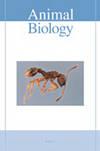Nest site selection and breeding ecology of the red-billed blue magpie Urocissa erythrorhyncha in central China
IF 0.9
4区 生物学
Q2 ZOOLOGY
引用次数: 0
Abstract
While knowledge on birds’ breeding ecology is essential for understanding avian adaptation and managing conservation, it is poorly studied for many species, even for some common species. The knowledge of the natural history of the red-billed blue magpie (Urocissa erythrorhyncha), a species widely distributed in China and Southeast Asia, is sketchy. Here we present detailed data of nest site selection and the breeding ecology of red-billed blue magpie in central China, and of the effects of nest predation and brood parasitism on reproductive strategies. Most nests were built on Phyllostachys sulphurea and Quercus acutissima. Breeding season ranged from March to August. The first egg was laid between early April and late July. The incubation period lasted 15 days and the nestling period, 18 days. Average clutch size was 4.6 eggs, and brood size at fledging was 3.3 young. Overall, 43.8% of nesting attempts successfully produced at least one fledged young. Nest predation and brood parasitism were the two main reasons for fledging failure, which mainly occurred after April. Correspondingly, U. erythrorhyncha showed a tendency to build nests higher up and have a smaller clutch size in late stages of the breeding season. This study provides the first reliable and comprehensive information on the reproductive parameters of U. erythrorhyncha, which will lay a foundation for further understanding this species’ biology and opens up an avenue for large-scale comparative studies of the Urocissa genus or higher-level taxa.华中地区红嘴蓝喜鹊巢址选择及繁殖生态学研究
虽然鸟类繁殖生态学知识对于理解鸟类适应和管理保护至关重要,但对许多物种,甚至是一些常见物种,研究得很少。红嘴蓝喜鹊是一种广泛分布于中国和东南亚的物种,其自然史知识尚不丰富。本文详细介绍了中国中部红嘴蓝鹊的巢址选择和繁殖生态,以及巢捕食和窝寄生对繁殖策略的影响。大多数鸟巢都建在竹和麻栎上。繁殖季节从三月到八月。第一枚蛋产于4月初至7月下旬。孵化期为15天,孵化期为18天。平均窝卵大小为4.6枚,孵化时幼仔大小为3.3枚。总的来说,43.8%的筑巢尝试成功地产下了至少一只成熟的幼崽。巢捕食和窝寄生是幼鸟繁殖失败的两个主要原因,主要发生在4月以后。相应地,在繁殖季节的后期阶段,红钩虫表现出在更高的地方筑巢的趋势,窝的大小也更小。这项研究首次提供了关于红钩藤繁殖参数的可靠和全面的信息,为进一步了解该物种的生物学奠定了基础,并为水仙花属或更高级别类群的大规模比较研究开辟了途径。
本文章由计算机程序翻译,如有差异,请以英文原文为准。
求助全文
约1分钟内获得全文
求助全文
来源期刊

Animal Biology
生物-动物学
CiteScore
2.10
自引率
0.00%
发文量
34
审稿时长
3 months
期刊介绍:
Animal Biology publishes high quality papers and focuses on integration of the various disciplines within the broad field of zoology. These disciplines include behaviour, developmental biology, ecology, endocrinology, evolutionary biology, genomics, morphology, neurobiology, physiology, systematics and theoretical biology. Purely descriptive papers will not be considered for publication.
Animal Biology is the official journal of the Royal Dutch Zoological Society since its foundation in 1872. The journal was initially called Archives Néerlandaises de Zoologie, which was changed in 1952 to Netherlands Journal of Zoology, the current name was established in 2003.
 求助内容:
求助内容: 应助结果提醒方式:
应助结果提醒方式:


